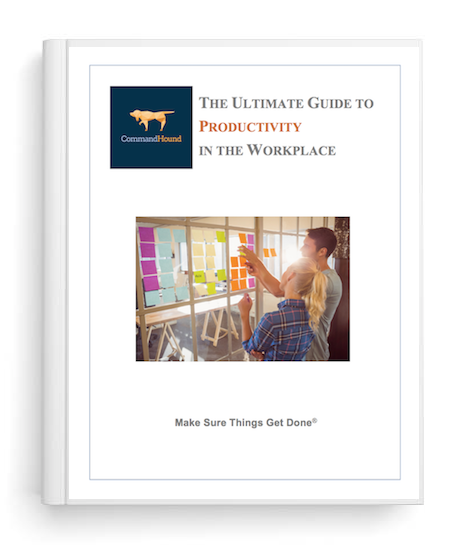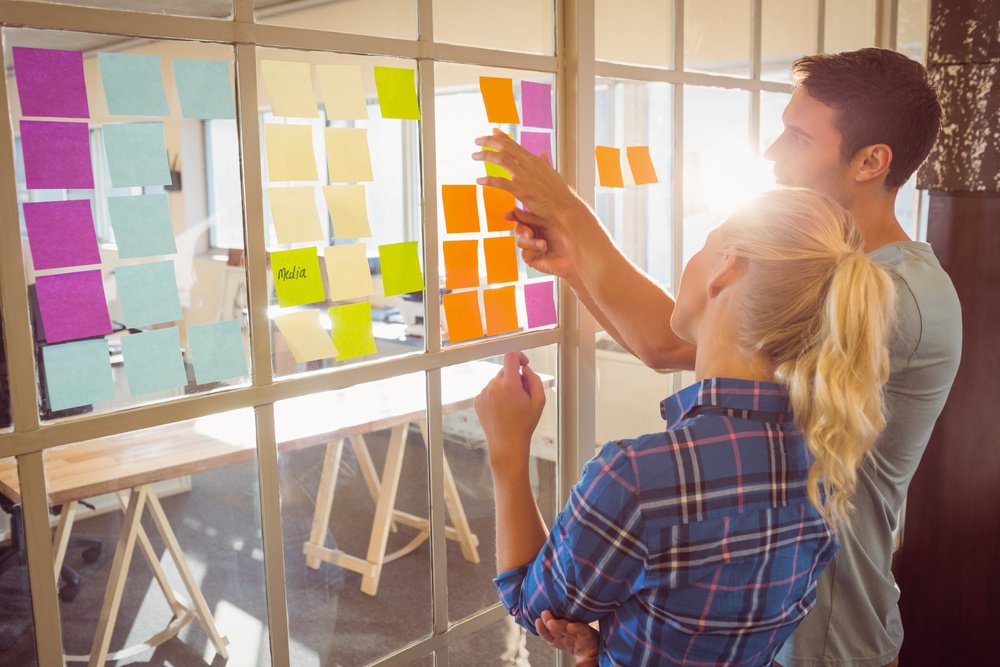The Ultimate Workplace Productivity Tips
Have you ever taken a short break at work to read an article online and accidentally fallen into an internet rabbit hole, only to emerge an hour later, praying that no one noticed how disconnected you were from your work?
Maybe you have entered a meeting with a coworker you haven’t seen in a while and spent the entire time catching up on what you did last summer without discussing anything related to the job at hand. Both of these common situations show just how seriously distractions can affect performance at work.
 Distractions are Common, and Negatively Impact Your Ability to Get Things Done
Distractions are Common, and Negatively Impact Your Ability to Get Things Done
Such distractions are only natural in the modern workplace, but they are seriously influencing the quality and quantity of work getting done at the office. A study published in the Journal of Experimental Psychology in 2014 found that interruptions of only two or three seconds (roughly the amount of time it takes you to move back and forth between tabs on your computer) were enough to double errors made by participants in assigned tasks. The potential for distraction in offices today has the potential to negatively impact the business’ bottom line, your team’s effectiveness, and your own chances at getting noticed in the workplace.
So what can you do to make sure things get done and you stay productive at work?
Start by reading The Ultimate Guide to Productivity in the Workplace. By assembling the latest research in productivity, interviews with clients in a variety of industries, and insights on recent productivity solutions, CommandHound has made it easy to develop the habits necessary to stay on top of your work and still have time to devote to your life outside of the office.
In this guide, you will find:
- Research on the most common drains on productivity in the office
- General hacks for learning how to avoid these common distractions
- Specific software solutions to help you become more productive in your own work
Not only will you learn what experts say is dragging you down, but you will learn solutions and aides to help you develop better habits. At each step along the way, CommandHound will support you on your journey to becoming more productive, all so you can get more done at work and get back to spending more time on real life.
Would you rather read the guide on your own time?

Let’s get started!
Table of Contents |
| Common Drains on Productivity at Work |
| Productivity Hacks |
| Productivity Software Solutions |
| Final Thoughts |
Common Drains on Productivity at Work
Based on our research, we have found that there are four major drains on productivity in the workplace.
- Multitasking
- Procrastinating
- Disorganization
- Distractions
But what actually happens when each of these affect you at work?
Multitasking
Multitasking was long considered a desirable ability, something that high achievers were able to do that doubled or tripled their productivity. Recent research, however, has started to change that perception, showing that multitasking can actually get in the way of real productivity.
The brain has a limited amount of bandwidth, which it can dedicate either fully to one task, or partially to a bunch of tasks. Think of it as running on a treadmill.
 If you run with both feet on the same treadmill, you’ll chug along at a solid pace and finish your workout at a normal time. Now imagine if you had to run with each foot on a different treadmill, each moving at a different speed. Your legs would feel like they were moving faster, but you’d actually be having a lot of trouble making any progress at all.
If you run with both feet on the same treadmill, you’ll chug along at a solid pace and finish your workout at a normal time. Now imagine if you had to run with each foot on a different treadmill, each moving at a different speed. Your legs would feel like they were moving faster, but you’d actually be having a lot of trouble making any progress at all.
It is the same with tasks in the workplace. Imagine if you have to make a presentation tomorrow. If you spend this afternoon constantly alternating between making that presentation, checking your email every few minutes, and chatting with whichever coworker stops by your desk, you’ll have trouble actually finishing your primary task. Just as in that research study that we mentioned earlier, where a two- or three-second distraction can double errors, any attempt to juggle tasks just makes your brain work harder than it needs to.
However, if you dedicate a solid hour or two to making the presentation and stay conscious of avoiding email and coworkers, you will have plenty of time to do both of those after you finish your presentation, and maybe you’ll even be able to leave the office early.
Curious to learn more about specific tips and tricks to make sure things get done and avoid multitasking? Skip ahead to Productivity Hacks, or download the Ultimate Guide to Productivity eBook right here.

Procrastinating
Procrastinating can also be a significant drain on your productivity, leading you to feel stressed out when deadlines approach or even turn in projects late. No one wants to feel that way, but sometimes procrastination can feel like an uncontrollable habit.
Some people have grown up believing that they are just procrastinators and cannot do anything about it. Some even view procrastination as a positive trait. It is important to remember, however, that there is both productive procrastination and unproductive procrastination.
 Productive procrastination involves steps that make accomplishing tasks and projects easier along the way, like making plans, brainstorming, and prioritizing to-do’s. Even if you feel like you are not actually doing the task, you are still making it easier for yourself in the long run by organizing and getting yourself in a working mindset.
Productive procrastination involves steps that make accomplishing tasks and projects easier along the way, like making plans, brainstorming, and prioritizing to-do’s. Even if you feel like you are not actually doing the task, you are still making it easier for yourself in the long run by organizing and getting yourself in a working mindset.
Unproductive procrastination is much nastier. It includes any activity that takes your attention away from the primary task, and can include things like reading articles or checking social media or talking to friends and coworkers in an effort to avoid the task at hand. This type of procrastination can go on for long enough that it actually interferes with your work, leading others to think of you as unreliable or always running late.
Fortunately, there has been a lot of research recently dealing with how to curb this unproductive procrastination. Read more about how to hack your productivity and do away with these unhelpful procrastination habits in Productivity Hacks.
Disorganization
Disorganization is another major issue affecting productivity in the workplace. Even though you might approach a day with the best intentions and try your best to get things done, a messy desk and disorganized computer can lead to huge problems.
 Imagine if a client calls and you can’t find their file. Or if you want to start working on a project but have to spend twenty minutes finding your notes. These might not seem like major problems each time, but added up they can really affect your business and the way that people perceive you at work.
Imagine if a client calls and you can’t find their file. Or if you want to start working on a project but have to spend twenty minutes finding your notes. These might not seem like major problems each time, but added up they can really affect your business and the way that people perceive you at work.
Studies show that the average person spends over 4 hours each week searching for papers. Executives, on average, spend an hour a day looking for missing information. These significant periods of time mean that stress and agitation become larger parts of your day, while your time for effectively doing your job decreases. This also means that the business bottom line suffers due to frustrated employees and customers who cannot get their questions answered when they want.
Beyond just the implications at work, studies have found that people who are more organized and predictable tend to eat better and live longer than their more disorganized counterparts. While disorganization has been linked to more creative thinking, organization in the workplace seems to have more regular benefits.
Learn more about how to make sure things get done in Productivity Hacks.
Distractions
Distractions are the final major impediment that we have found getting in your way with office productivity. These are essentially factors outside of your control that stop you from working on important things.
While procrastination, multitasking, and disorganization all start from within you, distractions are not quite within your control.
 Maybe you have a chatty coworker just one desk over, or your boss really likes to email you for check-ins every few minutes. No matter where these are coming from, distractions at work can be a major problem.
Maybe you have a chatty coworker just one desk over, or your boss really likes to email you for check-ins every few minutes. No matter where these are coming from, distractions at work can be a major problem.
Access to the internet is partly responsible for this. Now that email and social media are ubiquitous, you are constantly expected to be available and respond to messages within a few minutes or hours. This can have serious impact on your ability to focus on your work.
A survey recently featured in the New York Times found that respondents believed that access to the internet at work made them more productive and gave them more flexibility at work. But about 35 percent of people in this survey also said that they were working longer hours as a direct result of the internet. These findings were especially true for people who worked in offices. These longer hours clearly show that the major pitfall of access to internet at work is a decline in productivity.
Because these distractions are mostly outside of your control, it can seem impossible to fix them or eliminate them. That said, there are some easy habits you can develop to encourage those around you to value your work time and set boundaries so that regular distractions become a thing of the past.
So how do you stop multitasking, procrastination, disorganization, and distractions from getting in your way at work? Learn how to implement the Productivity Hacks below, and spend less time doing better work so that you can get back to the things that really matter.
Want to read more on your own time? Download the Ultimate Productivity Guide eBook.

Productivity Hacks
So how can you address these productivity drains in your workplace? You’ve made the first step by learning and realizing that these four factors affect you and constantly threaten to make you spend long, unproductive hours in the office.
So what are some specific tips and tricks you can use to make sure that multitasking, procrastination, disorganization, and distraction do not distract from your work? Read on!
How to Cure Your Multitasking
Say you sit down to write a report or prepare a presentation, and find yourself moving back and forth between multiple tabs on your computer or trying to read an important article at the same time. Because you have read in The Ultimate Guide to Productivity in the Workplace, you know that multitasking negatively affects your productivity and that you will not get as much done by moving between tasks. But it can be so hard to quit bad habits.
As with most of these productivity drains, the first step involves realizing when this specific issue is affecting you. With multitasking, this means taking stock of every time your attention is not fully on a single task. Note how many times you tab back and forth or try to start another task at the same time. This will give you a sense of what you are working with, as well as the motivation to change your bad habits.
 The most common strategy proposed by experts is to disconnect your internet when you really need to sit down and complete a task.
The most common strategy proposed by experts is to disconnect your internet when you really need to sit down and complete a task.
Since the internet is the primary source of multitasking wormholes like email and articles, limiting your access to it will certainly increase your productivity.
That said, completely shutting off your access to the internet at work might not be possible, since there are now certain expectations about how soon you are supposed to respond to incoming emails.
So what do you do if complete internet isolation is not possible? Try limiting the number of windows you have open on your screen, or even limit yourself to working on a smaller screen. Both of these changes focus your attention on a smaller space and make it more likely that you will be able to stay on task for longer.
Other suggestions from experts for monitoring your tasks and making sure that you prioritize only one task at a time might seem surprising, but only because they actually encourage you to take time off from your task.
The Pomodoro Technique is quite popular, and encourages you to mono-task in sprints. With Pomodoro, you set a 25-minute timer. When the timer goes off, you take a short break of no more than 5 minutes. Take a short walk, stretch your legs, and get away from your work for a short period of time. Then dive back into it! Every four 25-minute sessions, you get a longer break to cool off. This solution has been tried and tested for many years and has been proven to increase productivity by decreasing your ability to multitask.
Interested in more high tech solutions to make sure things get done? Check out the Productivity Software Solutions section of this guide below.
How to Stop Procrastination
Procrastination seems like a habit that you are born with and must simply learn how to tolerate without any possibility of controlling it, but this is quite simply not the case. Procrastination, like multitasking, is completely within your control the second you realize that you are doing it.
If you think that your procrastination might be getting in the way of your productivity, start by taking note of how many times throughout the day you find yourself delaying tasks.
 What do you normally do to procrastinate — play on your phone? Check certain websites? Start lengthy conversations with coworkers? Once you notice what behaviors you do when you are procrastinating, you’ll start giving yourself little mental nudges whenever you see yourself doing those things.
What do you normally do to procrastinate — play on your phone? Check certain websites? Start lengthy conversations with coworkers? Once you notice what behaviors you do when you are procrastinating, you’ll start giving yourself little mental nudges whenever you see yourself doing those things.
Beyond simply noticing what you are doing, there are a few solid habits you can train yourself to do in order to avoid unhealthy procrastination. A very simple one involves starting each day by making a list of tasks you need to accomplish by the end of the day. This will put these tasks in your mind and decrease the chances that you leave the office without finishing those to-do’s.
That said, many people find that they are still likely to procrastinate on these activities, pushing back the ones that seem less important for days on end. If you think that you will have trouble holding yourself accountable, enlist a friend or coworker to keep you on track.
Tell this person at the beginning of each day what you are trying to accomplish and with what you need their help. This will make sure that they check in on you throughout the day, notify you when they see you avoiding your tasks, and hold you accountable at the end of the day for whether or not you finished everything you set out to do.
Hesitant to share that you are likely to procrastinate with a coworker, or can’t think of someone reliable enough to keep you on track? There are now many different types of software solutions that will hold you accountable in similar ways. Check them out in our Productivity Software Solutions section below.
How to Reign in Your Disorganization
If you arrive to work every morning and have to spend the first part of your day trying to figure out what happened the day before, you probably suffer from disorganization. If you take more than 20 minutes throughout the day to organize yourself and your desk, then your disorganization is negatively influencing your productivity in the workplace.
Imagine being able to arrive at work and get started right away accomplishing tasks. This would not only make it possible for you to get more done in less time (and possibly leave the office earlier), but it would also draw the positive attention of your boss and make it clear to everyone in the office that you are on top of your duties.
So how do you make that happen? A very simple technique involves one task right before you leave each night and one task when you first get to the office in the morning.
Every evening when you leave your desk, spend 5 minutes organizing it. Put all loose papers in tidy stacks or folders where they belong, so that you’ll be able to find them more easily later. Close unnecessary tabs on your computer. Remove any unnecessary clutter so that you can arrive the next morning to a neat and tidy blank slate.
When you arrive at work the next morning, spend 5 minutes gathering your thoughts. Write out any lists of what you need to accomplish. Lay out whatever papers you might need during the day in tidy stacks. Make sure your computer tabs and files are all organized so that you can efficiently access them throughout the day.
With these simple habit changes, you will spend only 10 minutes each day organizing your workspace, and will be able to drastically improve your productivity. This 10 minute commitment each day allows you the freedom to move uncluttered through your day.
Curious to learn what sorts of software solutions support these organized habits? Read ahead to our Productivity Software Solutions section below.
How to Stop Distractions from Derailing your Productivity

Distractions, unlike the other productivity drains mentioned in this guide, originate from outside sources. They come from your chatty coworker, your boss who needs constant check-ins, or your teammates who are constantly calling unnecessary meetings.
All of these distractors get in the way of your productivity at work. So how do you avoid distractions from your officemates without seeming rude and disengaged?
There are actually some pretty simple methods to subtly disengage from distractors at work. One extremely effective technique comes from Francesco Cirillo, the creator of the Pomodoro Technique that we mentioned earlier. He suggests dealing with distractions in this way:
- Let whoever is distracting you know that you are working on something at the moment.
- Negotiate a time when you can dedicate your attention to their issue.
- Immediately schedule that follow-up.
- Return to your task and follow-up with your distractor at the agreed-upon time.
This technique allows you to continue feeling productive while quickly and respectfully dealing with any coworkers who approach you. These simple tricks will keep you working efficiently when you need to during the day, but there are also some effective tools that you can use to help yourself in this process. Read our Productivity Software Solutions section below to learn more.
Using WOOP to Help If You Just Can’t Figure It Out
After reading this, are you still not quite sure what is getting in your way with productivity? If you can’t quite nail down what is causing you to lose valuable hours in the office, it might be worth trying WOOP, a productivity solution developed by Dr. Gabriele Oettingen that provides a framework for accomplishing big goals one step at a time. WOOP stands for “Wish, Outcome, Obstacle, Plan,” and it outlines the four steps that make it most easy for you to actually accomplish your goals.
So how does the WOOP system actually help with outlining goals and achieving them? The process is based on the simple idea that “the obstacles that we think most impede us from fulfilling our wishes can actually help us to realize them.” It consists of four simple steps that help you figure out what your goal is, what is getting in the way, and how to overcome those obstacles:
Step 1: Wish
- Come up with your goal. What do you want to accomplish? A wish should be exciting, challenging, and realistic.
- Ex. I would like to be promoted to the position of VP
Step 2: Outcome
- What is your desired outcome? If everything goes right, what will happen?
- Think about how accomplishing your goal will make you feel.
- Ex. If I am promoted, I will feel good about myself because I have more responsibility and a larger salary
Step 3: Obstacle
- Imagine the personal obstacles that are preventing you from accomplishing your goal.
- Ex. When my manager asks me to finish a task, I often turn it in late because I get easily distracted by emails.
Step 4: Plan
- Develop a plan for how to overcome these obstacles.
- Think of a simple action or thought that can help you overcome each obstacle, then develop an If/Then plan for it.
- Ex. If I find myself being distracted from the tasks my manager wants me to finish, I will close my email and redirect my attention to that task.
Use this system to help you.

Productivity Software Solutions
We are lucky to live in a time when the internet and the apps available to us provide support in dealing with workplace issues. These apps can help out all types of professions and offices- from lawyers to Human Resources professionals, from remote offices to project management teams. Need tech solutions to solve your productivity problems? Look no further.
Monotasking Software
We mentioned the Pomodoro Technique earlier to cure yourself of your multitasking. Well, there are actually a variety of apps and online timers that you can use to try out the Pomodoro Technique for yourself.
- Tomato Timer: A very simple online timer to keep track of Pomodoro sessions
There are also a variety of apps out there that actually stop you from checking other websites while working on a project.
- SelfControl: A desktop app that prevents you from opening whatever pages you specify
- Freedom: A phone app that similarly restricts access to distracting apps
Try out all of these if you want some online help becoming a productive mono-tasker.
Tech Solutions for Workplace Distractions
 Distractions are harder to manage with an app or website, since they come from an outside source. But there are a few hacks that you can put in place on your computer whenever you want to mono-task on an important to-do:
Distractions are harder to manage with an app or website, since they come from an outside source. But there are a few hacks that you can put in place on your computer whenever you want to mono-task on an important to-do:
- Set an away message on your email
- Mark your calendar as “busy”
With these two simple tricks, anyone who emails you will receive an automatic response that you are busy and will get back to them soon, and anyone who checks your calendar will know that you are otherwise occupied. These two quick tricks will stop those constant tiny interruptions when you are trying to be productive.
Software to Stop Procrastination
As we discussed above, the easiest and most effective way to prevent procrastination is by making lists and coming up with a way to stick to them. If you don’t think you can keep track of a list on paper, try these simple to-do list apps:
- Wunderlist: Wunderlist effectively keeps track of your to-do’s, provides reminders for approaching self-set deadlines, and lets you sync across platforms
- Todoist: An app that provides similar features to Wunderlist but with different design principles.
- Evernote: This note-taking app allows you to create to-do lists in the form of personal notebooks.
- Want more options? Check out the 10 Best Task Management Software and Tools.
The one thing missing from each of these apps? That layer of accountability that makes sure you don’t continue procrastinating by just pushing tasks back on your list. So what apps are available to help you keep track of your to-do’s while also making sure that someone in your office holds you accountable?
- CommandHound: CommandHound is a software solution that was designed and built from the ground up to drive accountability. It is also the only tool that allows you to define escalation paths with different levels of urgency, and the only tool that keeps track of completion performance by individual and by process.
 A software solution like CommandHound will allow you, your team, and your manager to define tasks that need to be completed by each person. The individual tracking and escalation features allow users to truly delegate tasks and only worry about tasks that are falling behind. This saves management and oversight time across the board, letting you spend your time on the tasks that matter and not worry about being derailed by procrastination.
A software solution like CommandHound will allow you, your team, and your manager to define tasks that need to be completed by each person. The individual tracking and escalation features allow users to truly delegate tasks and only worry about tasks that are falling behind. This saves management and oversight time across the board, letting you spend your time on the tasks that matter and not worry about being derailed by procrastination.
Apps for Organizing
Disorganization can be helped with a variety of different types of online tools and strategies. Strategies for staying organized on the computer often revolve around emails, since your inbox has so many moving parts and has the potential to become disorganized very quickly.
One tried and true technique that experts have suggested for years is the Zero-Inbox policy. A goal that you can set for yourself is to maintain zero emails in your inbox, so that every email that comes to you is dealt with in a timely manner and then filed away.
With this system in place, you will always know the number of incomplete tasks you have to address by the number of emails still in your inbox. Every other email will have already been dealt with.
Outside of your email inbox, disorganization can be addressed like procrastination, with to-do lists. Software applications like those mentioned above can help you keep track of your tasks and make sure that you don’t let anything slip through the cracks.
With CommandHound, for example, you will always be able to keep track of your tasks, monitor how close they are to being due, and know that your managers will be able to gently nudge you to productivity when you are disorganized and losing track of your tasks. This powerful combination of organization and accountability will keep you safe knowing that nothing is falling through the cracks.

Final Thoughts
Maintaining productivity in the workplace can be extraordinarily difficult. The modern office is full of potential distractions that come from within or from external sources. Coworkers, the internet, and personal habits and hang-ups can get in the way of being truly productive at work.
However, with some simple and effective habit changes, it becomes possible to get all of your important work done in less time. This has positive effects on how your team members and managers see you, as well as on how much free time you have to pursue your own personal interests.
Multitasking, procrastination, disorganization, and distractions serve as the most common workplace problems to derail productivity. By using a combination of in-person and software solutions, you will have all of the tools available to change your habits and spend more time on the things that matter.
It all boils down to 3 components:
- Noticing when you are succumbing to these bad habits
- Having systems in place to deal with them
- Holding yourself and your coworkers accountable for a high level of responsiveness.
With these three components in place, your productivity in the workplace will skyrocket.

Interested in learning more about how CommandHound uses accountability to drive business performance and productivity? Interest in seeing how one software solution can keep your team on top of their tasks?
